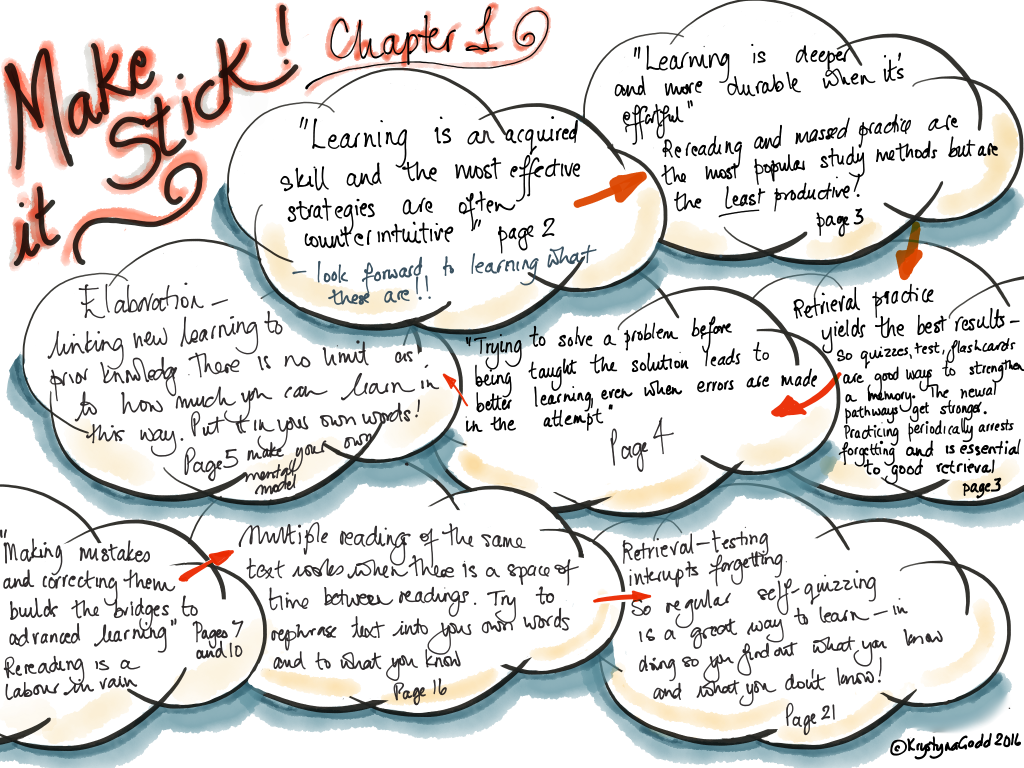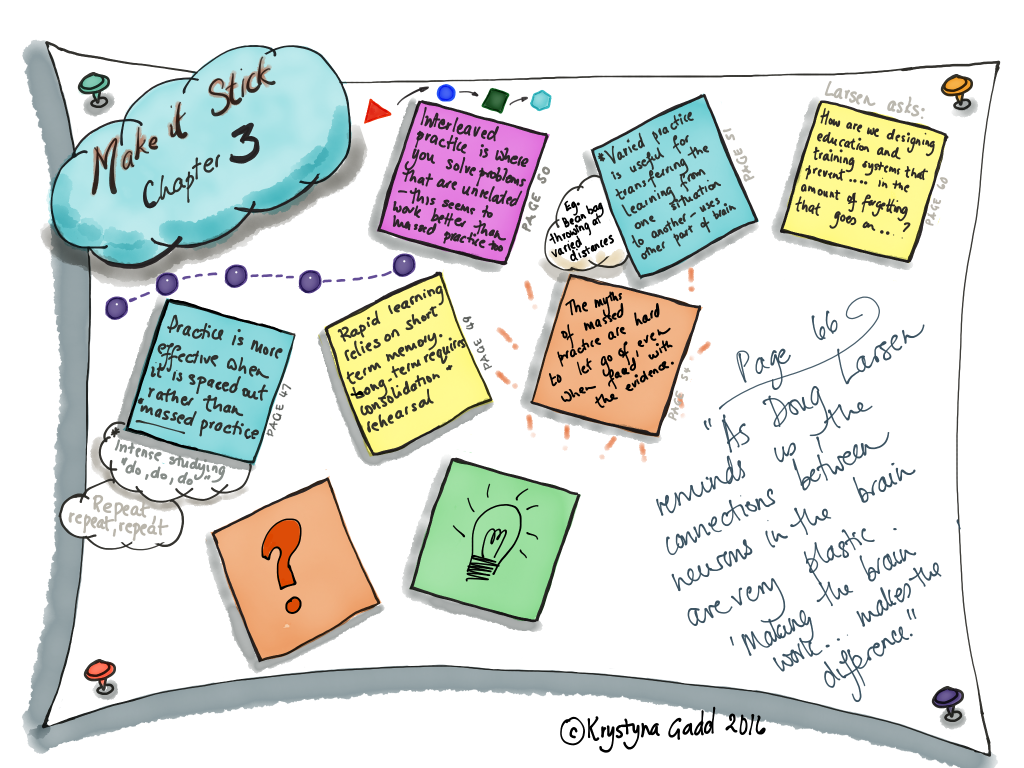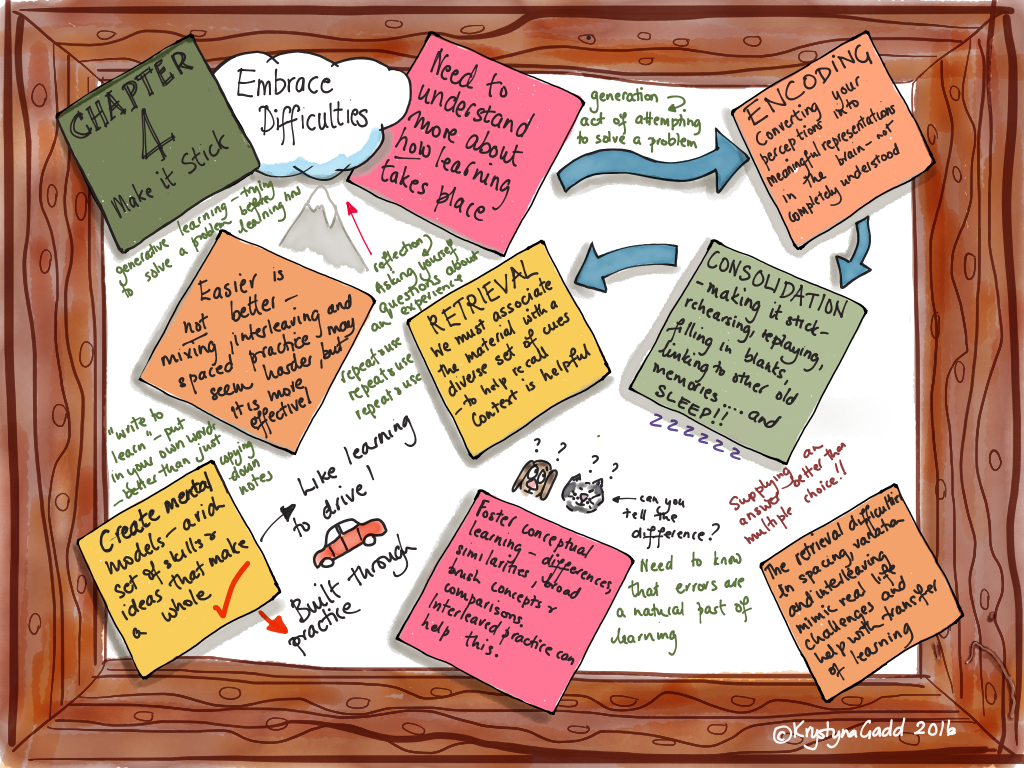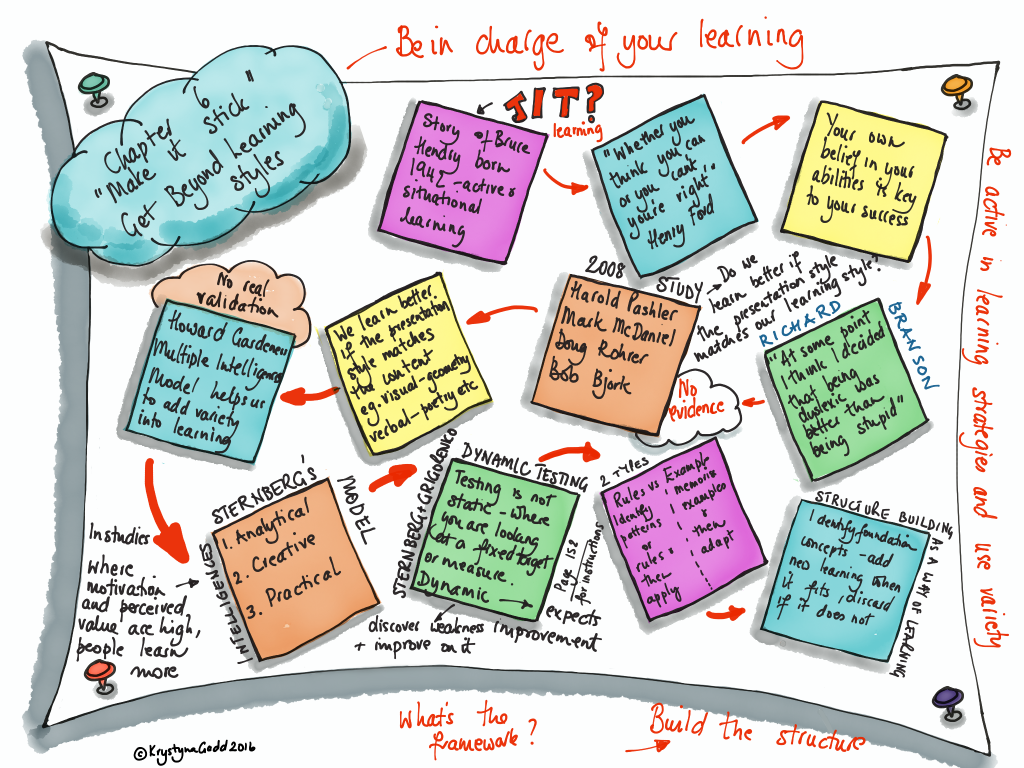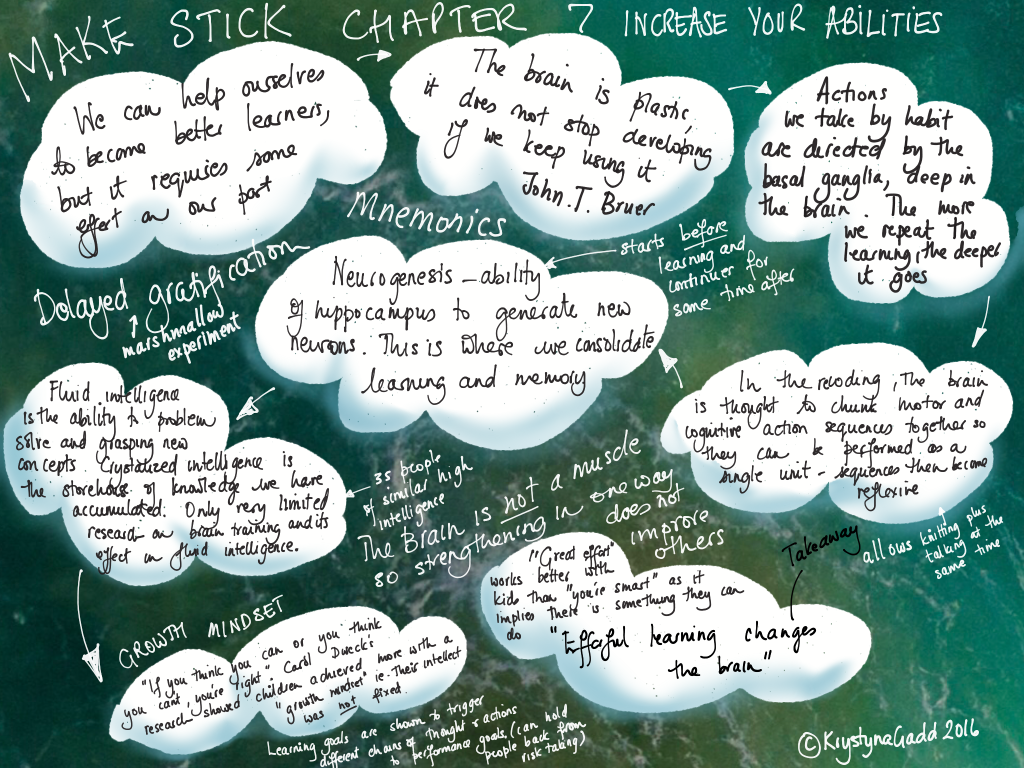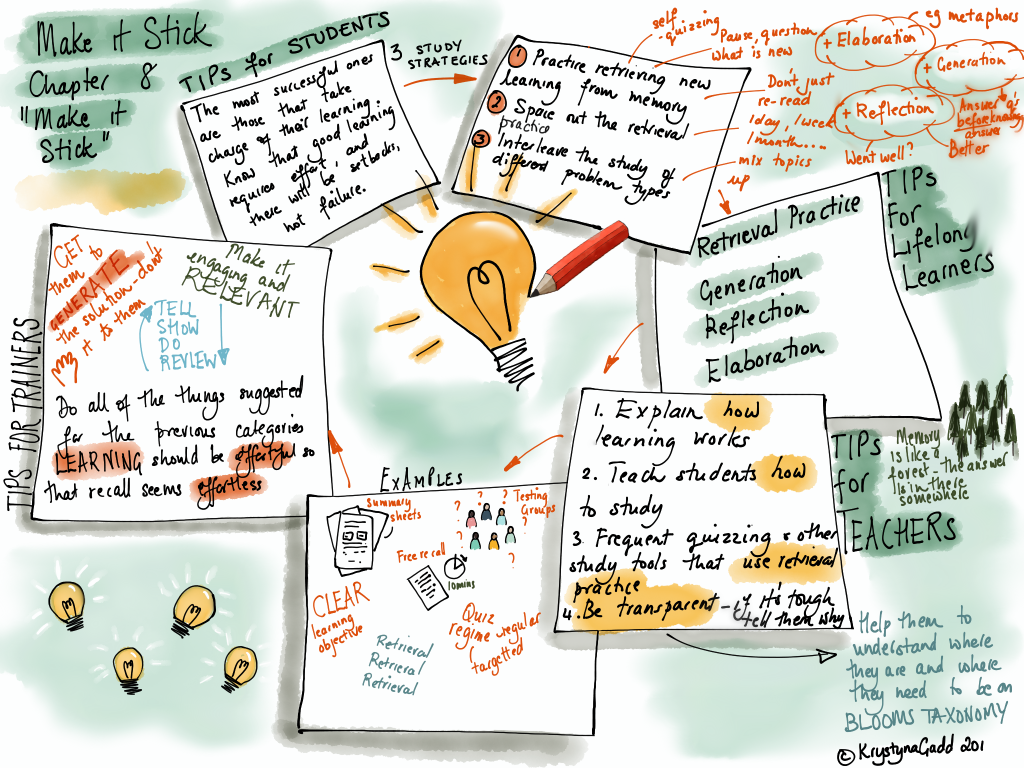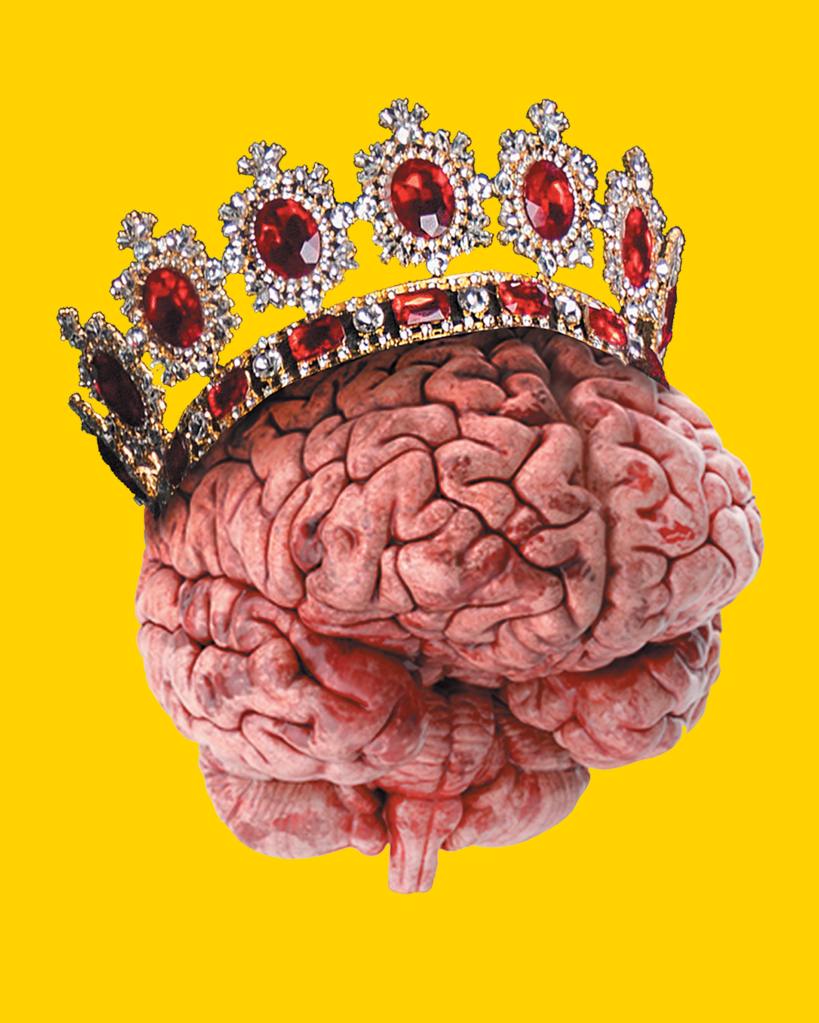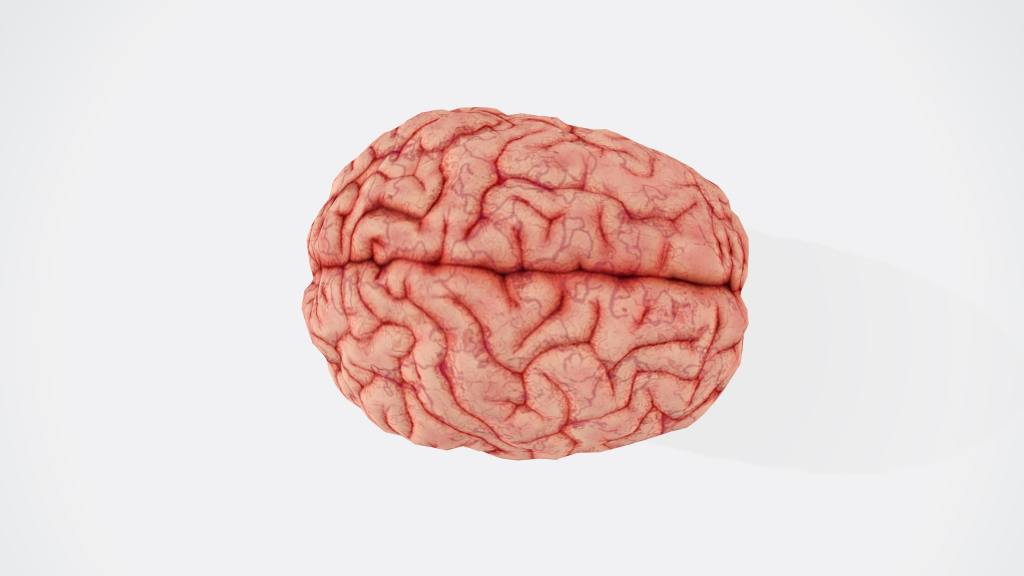Updated October 22, 2021
In their book, Make It Stick: The Science of Successful Learning (2014), principal author Peter C. Brown, and professors Henry L. Roediger III, and Mark A. McDaniel draw upon hard science to identify 8 concrete learning techniques proven to help learners encode, store, and retrieve memories long-term. (This blogpost is my attempt at practicing technique #4: elaboration.)
Brown’s 8 Techniques from Make It Stick
1. Generation
Generation is the process of attempting to provide an answer or a solution rather than waiting to be given the information or the answer. When you take a whack at solving a problem before actually being taught the concepts or method required for solving it, it is called generative learning (i.e., old-fashioned trial and error). Interestingly, “[generation] leads to better learning, even when errors are made in the attempt.” While critics of generative learning often believe direct instruction is more a effective method, the reality is that while students may seem to pick up concepts faster using direct instruction, information is less engrained, and thus more-quickly forgotten.
The writers used Ontario math instructors to illustrate generation. These teachers presented problems at the start of class, and then gave the students time to figure them out. “Hopefully the students will struggle. That initial moment of struggle prepares them for what they’ll learn later.” This retrieval practice technique is most powerful when developing a deep understanding of a subject; it’s less needful when you just want to be able to recall or do something specific.
2. Interleaving
Before defining this term, I confess that initially confused me the most. I think I confounded it with a different practice technique called scaffolding, which is where you give a learner a set of similar problems to solve, then slowly remove assistance over time. Interleaving is different than this however, because it is doesn’t have to do with how much or little support is offered to learners during practice. Interleaving is when you jump between two or more similar subjects as you are learning/practicing them. It’s almost like multitasking where focus is momentarily pulled away from a subject, forcing the learner to retrieve the information necessary to solve that kind of problem. This concept is in direct opposition to B.F. Skinner’s “drill-and-practice” learning theory of behaviorism. According to studies, by not repeatedly drilling the same problem sets, learners may not obtain as many right answers right away, but you keep students interested and they retain the material longer than those learners who employed mass practice.
In addition to keeping learners more engaged, there are two memory-specific benefits to mixing up practice of similar types of problems:
- By taking away the assumption that all problems are solved the same way, it requires the learner to identify the type of strategy to use in addition to simply solving the problem.
- It then helps learners’ brains differentiate between differences in the types of problems. This skill is critical for those who need to recognize problems and how to quickly solve them.
E.g., The authors shared the following sports experiment to illustrate the learning strategy of interleaving: There are two groups of baseball batters. One practiced the same pitch in blocks. The other group was thrown consecutive different types of pitches. The later group performed better in a game setting. (This study incidentally involves one of Merrill’s First Principle of learning, that practice should mirror real life as much as possible.)
3. Spacing & Forgetting
Cramming is only effective if you need to recall information within 24 hours. Space out your study if you want to encode working-memory information into long-term memory. Planning to study right before you forget is actually a tool for strengthening memory. There is a codified timeline for this called the Ebbinghaus Forgetting Curve.
“Trust the process.”
By allowing your mind time to forget what’s in it, your short-term memory will then need to re-encode the material, strengthening its neural pathway or your power to recall it. If you don’t follow this anti-forgetting model to the letter, you’ll know it’s time to go back to interleaved material when it is on the fringe of your memory.
Practice that’s spaced out, interleaved with other learning, and varied produces better mastery, longer retention, and more versatility. But these benefits come at a price: …it requires more effort. You feel the increased effort, but not the benefits the effort produces. Learning feels slower from this kind of practice, and you don’t get the rapid improvements and affirmations you’re accustomed to seeing from massed practice.
Peter C. Brown, Make It Stick
4. Elaboration
At first, I mistakenly thought that elaboration just meant adding on to a previously-stated idea. However, for the authors, it means to explain material in your own words. The science says that if you are able to do this, it is a good indicator of concrete understanding of the material. Elaboration is especially effective when learned material is then taught to someone else, which involves social motivation and feedback—both powerful learning tools. I’ve seen elaboration exemplified incredibly well on Reddit’s subreddit, r/ELI5 or Explain like I’m 5. In that online forum, people oftentimes pose complex questions while others break it down for them in a way that a kindergartener would understand. The book describes elaboration thusly,
Elaboration is the process of giving new material meaning by expressing it in your own words and connecting it with what you already know. The more you can explain about the way your new learning relates to your prior knowledge, the stronger your grasp of the new learning will be, and the more connections you create that will help you remember it later.
Peter C. Brown, Make It Stick
5. Retrieving
Retrieval practice is a fancy way of saying quizzing or testing. Most school teachers use graded tests as a final measure of a learner’s understanding. However, testing—although convenient (especially for large groups)—is usually not the best way to assess a learner’s mastery. Instead, non-graded or self-graded quizzes and tests should be regularly implemented to help learners practice retrieving information throughout the learning process.
Notoriously, most students study (try to get information to stick) by re-reading previously taken notes. This is proven to be a less-effective technique. Re-reading, as a study tool, has three strikes against it:
- It is time consuming.
- It doesn’t result in durable memory.
- And it often involves a kind of unwitting self-deception, as growing familiarity with the text feels like mastery of the content.
Using flashcards, on the other hand, is a prime example of practicing retrieval. Regarding best-practice for practice, The authors state,
Retrieval practice—recalling facts or concepts or events from memory—is a more effective learning strategy than review by re-reading. A single, simple quiz after reading a text or hearing a lecture produces better learning and remembering than re-reading the text or reviewing lecture notes. …The act of retrieving learning from memory has two profound benefits: 1) It tells you what you know and don’t know, and therefore where to focus further study to improve the areas where you’re weak. 2) Recalling what you have learned causes your brain to consolidate the memory, which strengthens its connections to what you already know and makes it easier for you to recall in the future.
Peter C. Brown, Make It Stick
In summary, retrieval practice = good; reviewing notes = bad. If you want further information on this topic, the authors published this informational PDF for teachers: http://pdf.retrievalpractice.org/RetrievalPracticeGuide.pdf
6. Reflection
Reflection is sort of a combination of retrieval practice and elaboration. Although I mention it later on in this list, it is a memory-strengthening tool intended to be used before, during, and after new material is presented. Brown expounds,
Reflection can involve several cognitive activities that lead to stronger learning: retrieving knowledge and earlier training from memory [e.g., ‘What did she say again?’], connecting these to new experiences [e.g., ‘How does this new information fit into my existing mental model of the universe?’], and visualizing and mentally rehearsing what you might do differently next time. [e.g., ‘How can this new information change things?’]
Peter C. Brown, Make It Stick
Learners can reflect many times and in many different ways throughout the learning process. The basic ingredients of reflection include analyzing and applying new material by asking yourself questions. The purpose of reflection is to allow the learner to assign deeper meaning to new material.
7. Calibration
This is a fancy way of saying feedback. Calibration often immediately follows retrieval practice. (Do you remember what retrieving is a fancy term for? …that’s right: quizzes and tests.) If you want to remember anything, you’ve got to know what you do and don’t know. That way you can target your gaps in knowledge using the other seven memory techniques.
One of the best habits a learner can instill in herself is regular self-quizzing to recalibrate her understanding of what she does and does not know. …The paradox is that those students who employ the least effective study strategies [reviewing notes] overestimate their learning the most and, as a consequence of their misplaced confidence, they are not inclined to change their habits.
Peter C. Brown, Make It Stick
8. Mnemonic Devices
When learners are just beginning to learn a subject, they can turn to memory cues, such as mnemonic devices (e.g., memory palaces, mind/cognitive map, etc.) to improve recall. Mnemonic devices help the mind to organize and cue the material for ready retrieval until it’s “locked in” long-term memory.
Practical Applications for Course/Curriculum Designers:
As learning architects, when we think about designing effective learning activities, we often focus on getting information into students’ heads. What if, instead, we focus on getting information out of students’ heads?
We can do this in numerous of ways; I’ll just list four:
- Focus activities on doing. Create less passive activities (like reading and watching), and instead get learners doing. Merrill’s first principles of instruction suggests that learning is promoted when new knowledge is applied by the learner (Merrill, 2002). Although creating active (participatory) learning activities (such as simulations) can be more challenging to design and develop, they offer learners more effective and dynamic learning experiences (Austin & Mescia, n.d.).
- Quiz for practice, not just competency. Use more low-stakes quizzes as exploratory, reflective learning exercises with the primary purpose to help students learn. This means creating quizzes that provide immediate feedback during the quiz. In order for this to be effective the feedback needs to be specific, describing why an answer is correct or incorrect. Point learners to resources that can help them rediscover the answers. This kind of formative feedback is an opportunity to reinforce concepts and can prompt students to dig deeper into a subject area. If using the quiz feature in a LMS or eLearning authoring tool (e.g., Adobe Captivate), it’s possible to provide customized feedback, bookmarks to previous instructions, and even include web links to additional resources.
- Encourage learners to review new ideas out of order. Corporate trainers often “chunk” their instruction in meaningful sequences. After teaching new information, create learning exercises and assignments that require students to draw upon concepts from previous modules/units of learning. When reviewing, do not approach learning modules or units as independent ‘chunks’ of learning, but fluid and porous ‘blocks’ that draw upon previous concepts that interlock and resemble real-world problems.
- Don’t make activities too easy. Make students work at learning by posing more questions and providing opportunities for discovery through various problem-based learning (PBL) activities (e.g., personal reflection, simulated interactions, elaboration with other students). Students need to solve problems by wrestling with concepts and ideas. This PBL component is perhaps the most challenging to integrate within an online learning environment, but it can also be the most rewarding.
Visual Book Chapter Summaries
